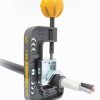Why was this bumped? Thought B-A-S was back for a moment!
You're not alone

There is a decent video on terminating swa
Except for the incorrect advice on connecting the earth. As he's done it, the integrity of the earth is dependent on the clamping pressure with a piece of plastic in the "sandwich" - and given that plastic will creep under pressure, it is "most likely" that the clamping pressure of the connections will be lost over time. Add a bit of tarnishing to the brass, and you've an unreliable earth.
Needs either two nuts on the gland (one to clamp it into the box, the second to clamp the banjo down onto the first*), or there are clamps (who's name escapes me at the moment, but I'm sure someone will remember for me) specifically for doing it in a more reliable way.
* Even this isn't reliable if not done right. There's play in the threads, so if you do the first nut up to "T A F" and then put the second nut on, as the plastic creeps, the first nut will be free to move by however much play there is in the threads - and the clamping pressure of the second nut will be relieved.
Instead, don't fully tighten the first nut, so that when you tighten the second one, it pushes the first nut down a bit harder, taking up the play in the threads - if you imagine how the nuts would be if the plastic panel weren't there, that's how you want them when the plastic is there.
A bit like doing the wheel bearings on the Land Rover. Takes a bit of judgement to get the first nut about right, so that when the second nut is screwed down, the bearing has the right amount of free play in it.



